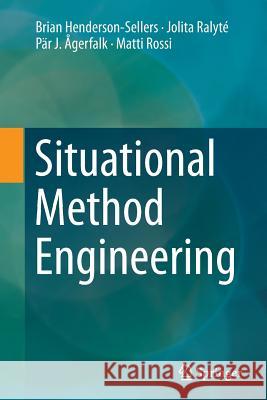Situational Method Engineering » książka



Situational Method Engineering
ISBN-13: 9783662522639 / Angielski / Miękka / 2016 / 310 str.
Situational Method Engineering
ISBN-13: 9783662522639 / Angielski / Miękka / 2016 / 310 str.
(netto: 191,66 VAT: 5%)
Najniższa cena z 30 dni: 192,74
ok. 22 dni roboczych
Dostawa w 2026 r.
Darmowa dostawa!
This book explains situational method engineering and details how to apply it in software development. It features step-by-step explanations, from the basics to the customization and quality assessment of constructed methods. Includes industrial case studies.
"This book offers a comprehensive body of knowledge related to the Method Engineering discipline. It provides a summary and synthesis of all past efforts in this domain and clarifies the domain terminology. I suggest it to every researcher interested in the art of method design, not only in software engineering but also in other fields." Marko Bajec, University of Ljubljana, Slovenia
"I am confident this text will prove an invaluable resource for those interested in improving the standard of software development and the resulting software applications." from the foreword by Mary O'Kane, NSW Chief Scientist & Engineer, Sydney, Australia
"This book deftly balances the advantages of situational method engineering in terms of its practical application, underpinned by the solid theory from worldwide research. I heartily recommend it for both researchers and practitioners." from the foreword by Julian Edwards, Chief Operating Officer, Object Consulting, Sydney, Australia
Part I SME Basics.- Chapter 1 Introduction.- Chapter 2 Method chunks, method fragments and method components.- Chapter 3 Method Engineering as a Social Practice.- Chapter 4 Formal descriptions.- Part II Applying SME in Practice.- Chapter 5 Identification and construction of individual method chunks/fragments.- Chapter 6 Processes for creating a methodology from method parts.- Chapter 7 Tailoring a constructed method.- Chapter 8 Assessing quality.- Chapter 9 Examples of constructed processes.- Part III The Future of SME.- Chapter 10 Recent advances in SME.- Chapter 11 Final summary and future work.
Brian Henderson-Sellers is Director of the Centre for Object Technology Applications and Research and Professor of Information Systems at the University of Technology, Sydney. He has authored over a dozen books on object and agent technologies and is well-known for his work in OO methodologies and in OO metrics. In 1999, he was voted number 3 in the Who’s Who of Object Technology. Brian has been a member of the Review Panel for the OMG’s Software Process Engineering Model standards initiative and a member of the UML2.0 review team, was General Chair of the IFIP WG8.1 Working Conference on Method Engineering and is Co-Editor of the ISO/IEC 24744 International Standard “Software Engineering Metamodel for Development Methodologies”.
Jolita Ralyté is a senior researcher and lecturer at the University of Geneva’s Department of Information Systems. Her research areas include situational method engineering, information systems development methods, information systems evolution and interoperability, requirement engineering, and services science. Currently she is a Vice-Chair of the IFIP WG 8.1 and leads the Method Engineering Task Group within the IFIP WG 8.1.
Pär Ågerfalk is a professor at Uppsala University’s Department of Informatics and Media, where he holds the Chair of Computer Science in Intersection with Social Sciences. His research on open source software development, open innovation, globally distributed and flexible software development, conceptual modelling and method engineering has appeared in a number of leading journals and conferences.
Matti Rossi is a professor of information systems at Aalto University School of Economics. He has been involved in the development of research prototypes and commercial products, including MetaEdit Personal, a single user CASE tool, and MetaEdit+, a multi-user integrated CASE tool, selected among the three most innovative new software tools at CeBIT 95 by Byte and used for the development of user interfaces for Nokia’s latest generations of mobile phones.While previously available methodologies for software – like those published in the early days of object technology – claimed to be appropriate for every conceivable project, situational method engineering (SME) acknowledges that most projects typically have individual characteristics and situations. Thus, finding the most effective methodology for a particular project needs specific tailoring to that situation. Such a tailored software development methodology needs to take into account all the bits and pieces needed for an organization to develop software, including the software process, the input and output work products, the people involved, the languages used to describe requirements, design, code, and eventually also measures of success or failure.
The authors have structured the book into three parts. Part I deals with all the basic concepts, terminology and overall ideas underpinning situational method engineering. As a summary of this part, they present a formal meta-model that enables readers to create their own quality methods and supporting tools. In Part II, they explain how to implement SME in practice, i.e., how to find method components and put them together and how to evaluate the resulting method. For illustration, they also include several industry case studies of customized or constructed processes, highlighting the impact that high-quality engineered methods can have on the success of an industrial software development. Finally, Part III summarizes some of the more recent and forward-looking ideas.
This book presents the first summary of the state of the art for SME. For academics, it provides a comprehensive conceptual framework and discusses new research areas. For lecturers, thanks to its step-by-step explanations from basics to the customization and quality assessment of constructed methods, it serves as a solid basis for comprehensive courses on the topic. For industry methodologists, it offers a reference guide on features and technologies to consider when developing in-house software development methods or customising and adopting off-the-shelf ones.1997-2025 DolnySlask.com Agencja Internetowa
KrainaKsiazek.PL - Księgarnia Internetowa









